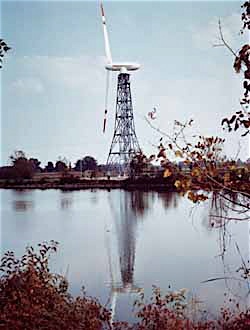Wind energy research reaps rewards — sort of
When Larry Viterna finally Googled himself, he
could hardly believe the results: hundreds of references to an analytical model
he developed in 1981 to predict the power generated by wind turbines during high
winds.

NASA’s first experimental wind turbine in Sandusky, Ohio
We’ve all been tempted. Some of us have tried it more than once.
For some reason, it never crossed Larry Viterna’s mind to type his own name into a search engine until late last year. An accomplished NASA engineer and manager with a Ph.D., he could expect to find plenty of entries.
But when Viterna finally Googled himself, he could hardly believe the results: hundreds of references to an analytical model he developed in 1981 to predict the power generated by wind turbines during high winds. These clean and efficient machines look like enormous fans and convert wind into electricity.
At the time of publication, wind energy experts had dismissed his theory. “It was quite controversial because it contradicted existing theories,” Viterna said. “I was known around the world as a bit of a quack.”
Viterna and NASA got involved in wind energy during the energy crisis of the 1970s. Increased consumption and an oil embargo against the United States and other western countries had contributed to record-high gas prices and lines at the pump. In response, President Richard Nixon set up a federal task force to explore renewable energy sources, such as solar panels, hydrogen and wind turbines.
With funding from the National Science Foundation and the Department of Energy, NASA constructed and operated its first experimental wind turbine at Plum Brook Station in Sandusky, Ohio. Throughout the program, NASA developed a total of 13 experimental wind turbines.
“It was a fun project,” said Viterna, who led the aerodynamics team from 1978 to 1981. “Wind energy was a very hot topic. It was key in the minds of Americans, and we were right in the middle of leading the effort.”
A major design flaw in those days was rooted in fixed-pitch blades. Viterna and Bob Corrigan used data from their tests to reverse engineer an analytical model to predict power in high winds. Viterna and Corrigan presented the model that year at an international workshop, where it received a tepid response.
The wind energy program ended later that year, and both engineers moved along in their careers. Viterna became NASA Glenn’s Lead for Center Strategy and Business Development, and Corrigan went on to manage an International Space Station support project.
Recently — on a whim, Viterna searched the Internet for his name and the word “wind.” He learned that experts in the wind energy field now commonly refer to the analytical model as “Viterna & Corrigan” or “the Viterna method.”
Twenty-five years after publishing their paper, the two engineers are being recognized for their work. Both of them received a Space Act Award from NASA’s Inventions and Contributions Board. And in June, Viterna will accept a Blue Marble Award at NASA’s Environmental and Energy Conference.
To top it all off, last August, the Department of Energy approved the code as part of its design tools for worldwide certification of wind turbines.
Too bad the politicians in charge of scientific budgets and decisions on energy couldn’t see beyond their noses — or the next election — in 1981. I don’t think the crowd in Washington, today, is any better.
Posted: Wed - June 7, 2006 at 06:14 AM